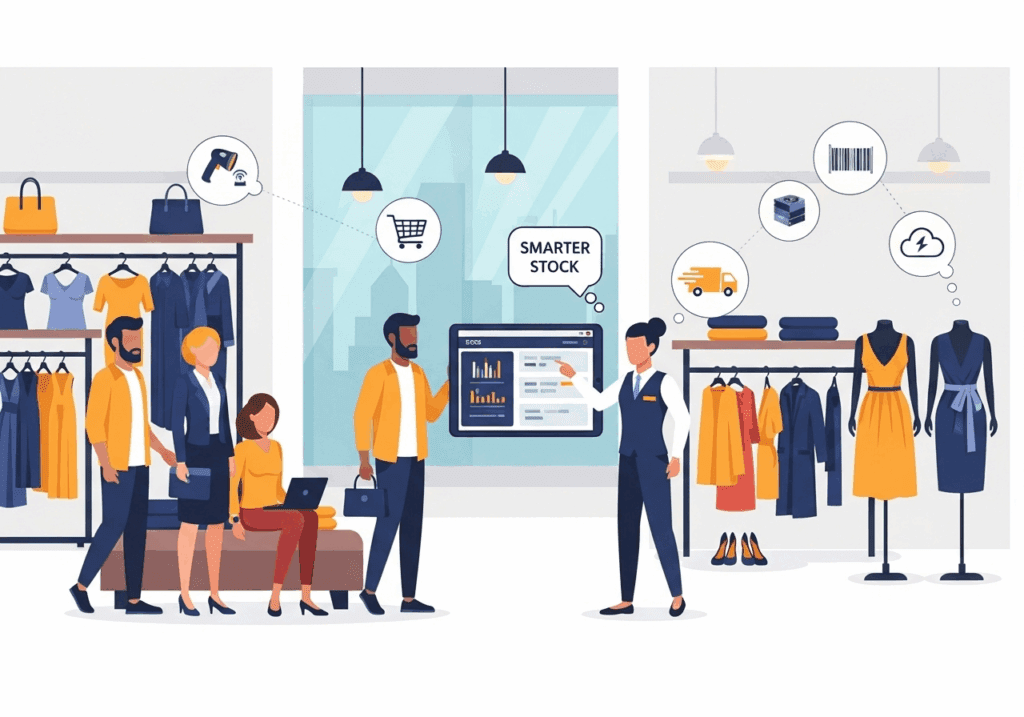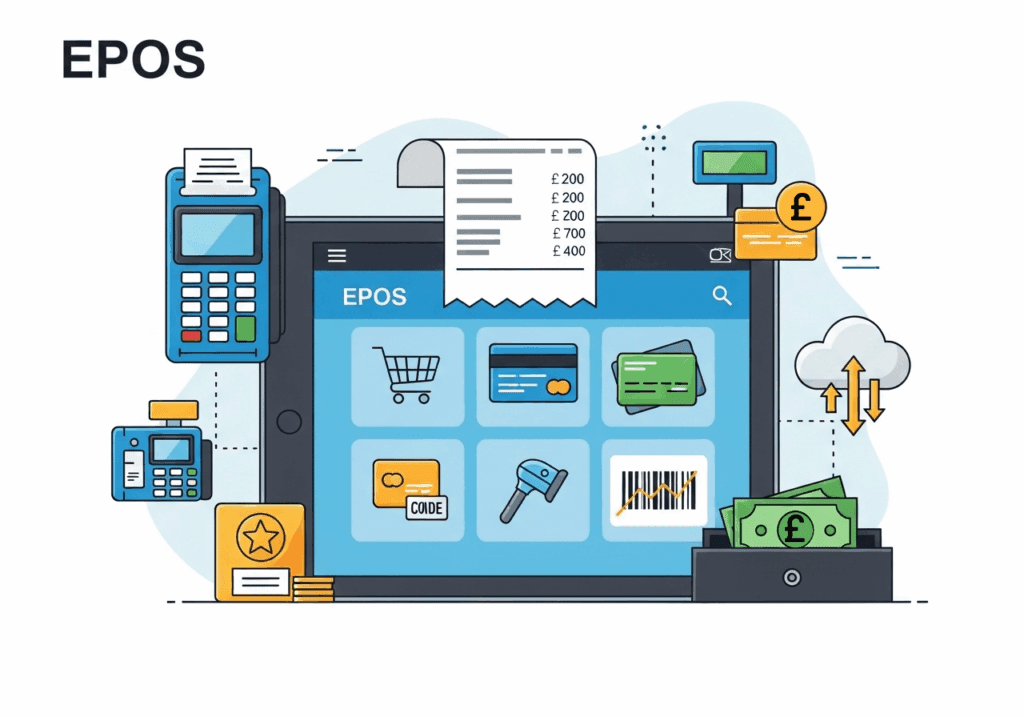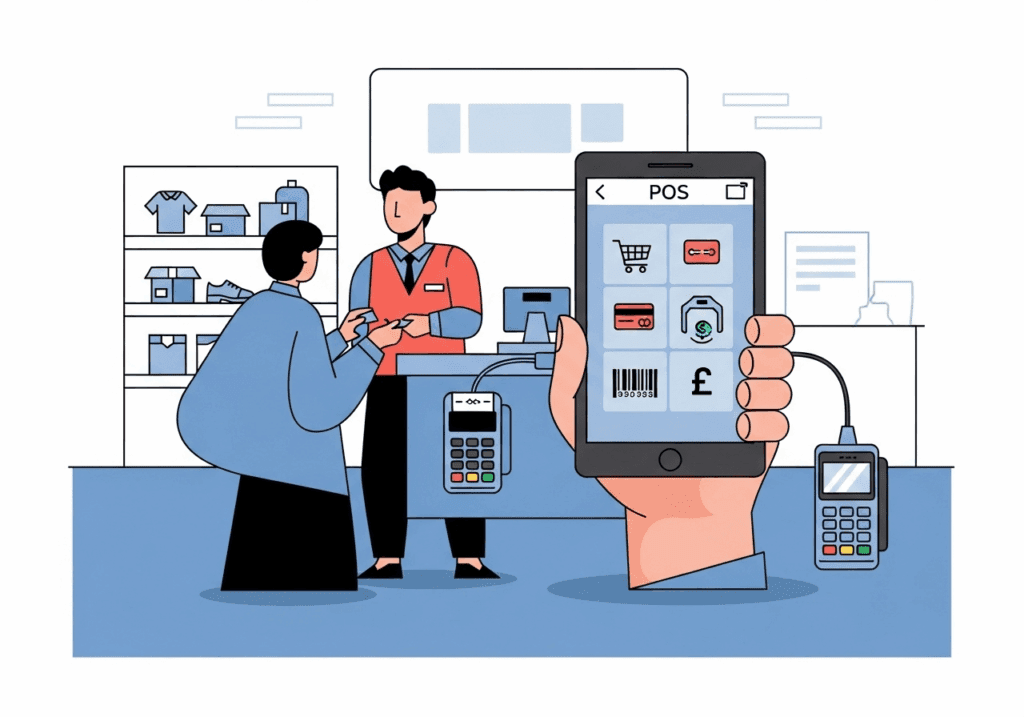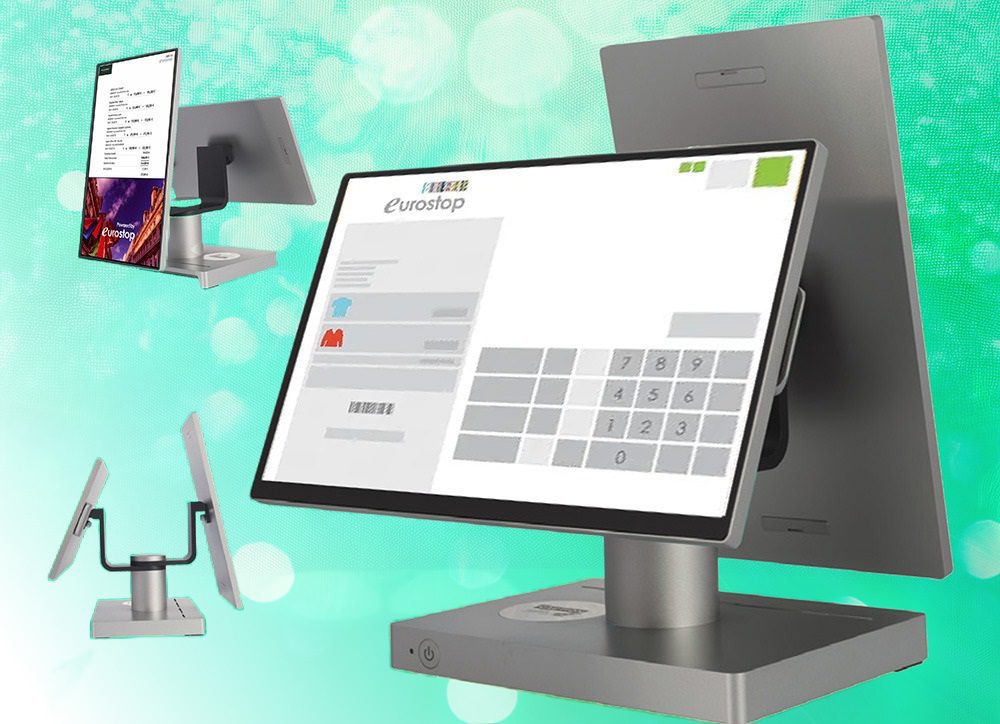Harnessing Retail EPOS Software for Smarter Stock, Sales, and Strategy

In retail, effective stock management, accurate forecasting, and actionable insight can be the difference between meeting customer demand and losing valuable sales. Modern retail EPOS software equips retailers with the tools to monitor availability, forecast trends, optimise promotions, and resolve supply issues before they affect business performance. Here is some more insight from Eurostop as to how modern EPOS software can benefit you. Get Visibility of Your Availability Accurate, real-time stock visibility ensures shelves remain stocked and customers can find what they need. EPOS software highlights product gaps at store and regional levels, enabling targeted interventions to prevent stockouts, lost sales and strengthen customer loyalty. Manage Promotional Activity From individual store execution to national campaign performance, EPOS data reveals whether promotions are delivering their expected uplift. Retailers can quickly pinpoint underperforming offers and take corrective action, ensuring every campaign delivers measurable returns. Prepare to Meet Demand Accurate cover information can allow retailers to identify inventory challenges before they occur. By knowing exactly what stock you have sold and hold, you can utilise trend insights to make sure that you have enough cover, or respond effectively. Retailers can replenish ahead of high-demand periods or events, reducing the risk of stockouts and missed revenue opportunities. Identify Excess Stock Pockets On the flip side, retaining too much stock in a particular location means that it isn’t available where it is needed, ties up capital expenditure and costs the business in terms of storage. EPOS helps retailers maintain accurate stock levels, identify such situations and redeploy products to higher-performing locations, consider a promotion or adjust ordering patterns. This approach reduces waste, optimises shelf space, and improves cash flow. Put a Monetary Figure on Lost Sales Value By converting stockout data into measurable financial terms, as part of your retail software architexture, EPOS software gives retailers the evidence they need to prioritise problem areas and justify operational changes. This insight drives targeted improvements with tangible ROI. Migration from Legacy to Modern EPOS Upgrading from outdated systems to a modern EPOS platform is more than a technical change; it’s a business transformation. Legacy platforms often limit visibility, delay reporting, and restrict integration with essential tools. Modern systems deliver seamless, real-time data across channels, enabling agile decision-making and faster problem resolution. Business Transformation Benefits Improved Decision-Making: Connected technology provides a single view of stock and centralised, accurate data enables faster and more strategic decisions. Operational Efficiency: Accurate and specialised retailreporting streamlines daily operations. Enhanced Customer Experience: Better stock control reduces the chance of disappointed shoppers. Scalability: Modern systems support business growth and expansion into new sales channels. Cost Analysis and ROI While migrating to modern EPOS software involves an initial investment, the long-term returns can be substantial. Retailers benefit from reduced lost sales, optimised stock levels, and more effective promotions, often recovering costs within months. Over time, the system transitions from a functional necessity to a key driver of profitability. Contact Eurostop today for retail EPOS software and more! Modern retail EPOS software is more than just a transaction tool; it’s a strategic business asset. By improving visibility, boosting operational efficiency, and enabling data-driven decisions, retailers can stay ahead of market shifts, meet demand with confidence, and build sustainable growth. Learning by contacting Eurostop online or calling +44 (0) 20 8991 2700.
The Future of Retail: Why London Businesses Need All-in-One EPOS Software

The retail landscape has transformed dramatically in recent decades, and London, one of the world’s most dynamic retail hubs, is leading that evolution. At the core of this shift is the rise of all-in-one EPOS software in London. These systems are redefining how retailers operate, interact with customers, and manage growth. But what exactly is an all-in-one EPOS, and why is it so vital for businesses today? Here, Eurostop provides some key insight. What Does All-in-One EPOS Mean? An all-in-one EPOS (Electronic Point of Sale) system refers to a fully integrated solution that combines hardware and software into a single, cohesive platform. Unlike traditional POS setups that rely on multiple disconnected components, an all-in-one system centralises everything from sales transactions and inventory tracking to customer relationship management and reporting. This integration simplifies workflows, reduces errors, and enhances the retail experience for both employees and customers. From Legacy Systems to Smart Retail The concept of the point-of-sale system isn’t new. Early iterations, like electronic cash registers in the 1970s and basic computerised systems in the 1980s, laid the groundwork. The 1990s saw more advanced software capabilities, while the 2000s introduced cloud computing to the retail sector. In the 2010s, integrated, cloud-based solutions started gaining traction. Now, in the 2020s, smart EPOS systems not only unify in-store and online operations but also leverage AI and real-time analytics to drive business decisions. This journey illustrates how retailers must continually adapt to maintain efficiency and customer satisfaction in a fast-changing environment. The Benefits of All-in-One EPOS Software For London retailers navigating a competitive market, all-in-one EPOS software offers several operational and strategic advantages. First, it significantly improves day-to-day efficiency. Transactions are processed faster, inventory is automatically updated, and administrative tasks are reduced. This allows staff to focus more on customer engagement rather than managing fragmented systems. From a design perspective, modern all-in-one EPOS terminals offer a sleek, compact footprint that enhances checkout ergonomics and saves valuable counter space. Adjustable screens, integrated card readers, and barcode scanners contribute to a clean, professional appearance while improving employee comfort. Customer experience also improves with an all-in-one solution. Whether a customer shops in-store or online, the interface and experience remain consistent. Orders, returns, loyalty points, and preferences are tracked seamlessly across channels, making omnichannel shopping a reality rather than a challenge. From a business standpoint, all-in-one EPOS software is a long-term investment. While the initial setup cost may seem significant, the consolidation of software licenses, maintenance, and IT support leads to notable cost savings over time. Additionally, the system’s scalability means it can grow with your business. Whether you’re adding new locations or expanding your online presence, you won’t need to overhaul your entire infrastructure. Another major advantage lies in real-time reporting and analytics. Integrated dashboards provide instant insights into sales performance, inventory levels, and customer behaviour. These data points help retailers make faster, smarter decisions, whether it’s reordering best-sellers, adjusting staff schedules, or launching targeted marketing campaigns. Choosing the Right All-in-One EPOS for Your Business Not every EPOS system is created equal, and choosing the right one requires a clear understanding of your business needs. Retailers should consider the level of customisation offered, compatibility with existing software and payment processors, data security measures, and the quality of customer support provided. Flexibility and future-readiness are crucial, and your system should be able to adapt as your store evolves. A high-quality EPOS solution should also allow you to expand without the need for major IT overhauls. In short, it should act as a stable, scalable backbone for your operations, capable of supporting your business today and well into the future. Why Eurostop Is the Right Partner for Retailers in London Eurostop offers industry-leading EPOS software tailored to the needs of modern retailers in London. Our systems are designed to deliver a seamless experience across physical and digital storefronts while offering the depth of features required to manage inventory, process payments, analyse sales, and support customer engagement, all from one integrated platform. With a reputation for innovation and reliability, Eurostop empowers businesses to streamline operations, improve customer satisfaction, and scale effectively. Contact us for more about our all-in-one retail master software! In a city where retail expectations are high and competition is fierce, having the right EPOS partner can make all the difference. Eurostop provides not just EPOS software, but a complete retail solution that evolves with your needs. Contact us online today to learn more or call +44 (0)20 8991 2700.
How Mobile Point of Sale Systems Are Transforming Retail Environments

In today’s evolving retail landscape, delivering fast, flexible, and seamless customer experiences is no longer optional; it’s essential. Relying solely on traditional point of sale (POS) systems, often tethered to checkout counters, can mean you are no longer able to keep pace with customer expectations. Mobile point of sale systems (mPOS) are stepping in to close this gap, helping retailers boost efficiency, mobility, and satisfaction across a range of retail settings. Here, the team from Eurostop has collected some more information about the benefits of mobile point of sale solutions. Frictionless Experiences That Drive Engagement Mobile POS solutions are built for convenience and speed. Operated through tablets or handheld devices, these systems allow staff to serve customers from anywhere: on the sales floor, in fitting rooms, or even curbside. This eliminates long queues and improves service times, creating a frictionless user experience that today’s shoppers expect. Because mobile POS solutions are built with an intuitive UX, designed to maximise screen real estate , staff can be trained quickly. Associates are empowered to handle transactions, look up product details, check inventory, and manage returns or exchanges without ever leaving the customer’s side. The result is faster service and greater customer satisfaction. Streamlined In-Store Processes for Efficiency Mobile POS systems aren’t just for ringing up sales. When integrated with key systems like inventory management, CRM platforms, and order fulfillment tools, they serve as powerful operational hubs. Associates can track stock levels, manage customer profiles and personalise service, and view real-time data, all from a single device. This connected technology simplifies daily tasks, reduces operational bottlenecks, and allows staff to focus on what matters most: delivering excellent service. By minimising handoffs and manual work, mobile POS helps stores run more efficiently with fewer errors and better visibility into operations. Happier Customers Through Personalised Service Customer expectations have shifted from simply a transactional service to exceptional service that stands out in a crowded arena. This can involve for example personalised experiences where shoppers feel like the brand knows and understands them, is reactive and consequently builds a long term relationship. Mobile POS helps retailers meet this demand by enabling staff to deliver tailored recommendations, upselling and cross selling and support. With access to customer data, such as purchase history, preferences, and loyalty status, associates can provide more relevant suggestions and real-time updates on promotions or stock availability. This level of personalisation builds trust and enhances the overall shopping experience. Customers receive faster, more informed service, and are more likely to return, boosting retention and long-term value. Versatility Across Retail Settings One of the key advantages of mobile point of sale systems is their adaptability. They’re not limited to traditional retail stores; they perform just as well in unconventional or temporary environments, including: Pop-up shops and temporary retail: Mobile POS systems provide an option to scale up quickly and with no footprint they are ideal for short-term retail locations. They allow for full sales functionality without the need for permanent infrastructure. Market stalls and outdoor events: Compact and wireless, mPOS solutions operate in non-traditional spaces, providing reliable transaction processing and inventory tracking even without a fixed location. In-store mobility: Whether assisting customers in fitting rooms, or for that matter anywhere on the shop floor, staff can deliver uninterrupted service without requiring customers to queue. Delivery, curbside, and field sales: Sales teams can accept payments, update customer records, and issue digital receipts on the go, ideal for home visits or remote service areas. Business continuity and redundancy: Because mobile POS operates independently of fixed systems, it serves as a backup during outages, allowing sales to continue without disruption, and devices may also be utilised during busy promotional period allowing you to react to increased foot traffic Why Eurostop for Mobile POS At Eurostop, we understand the need for agile, connected retail solutions. Our mobile point of sale systems are designed to work seamlessly with your existing retail infrastructure, supporting omnichannel operations and enhancing the customer journey at every touchpoint. Whether you’re looking to streamline in-store workflows, launch a pop-up shop, or ensure business continuity, Eurostop’s mobile POS delivers the flexibility and performance today’s retailers require. Empower your staff, delight your customers, and future-proof your retail operations with Eurostop. Contact us online today or call +44 (0) 20 8991 2700 for more information.
Maximise ROI & Strengthen Retail Operations with Integrated EPOS Software

In a rapidly evolving retail landscape, operational efficiency, real-time insights, and customer loyalty are essential to long-term success. To stay competitive, retailers must adopt tools that do more than process sales; they need intelligent systems that unify operations, optimise workflows, and protect financial data. This is where integrated EPOS software plays a critical role. At Eurostop, our retail EPOS software is built to deliver measurable gains in performance, profitability, and customer satisfaction. 1. Accurate Inventory Control to Lower Losses Effective inventory control is a cornerstone of retail profitability. Overstocking wastes capital and storage space, while stockouts result in missed sales and dissatisfied customers. Eurostop’s integrated EPOS software provides real-time inventory and cover visibility, recommended purchase orders, and seamless supplier integration. This enables businesses to maintain ideal stock levels and minimise costly errors. ROI Impact: Reduce holding and warehousing costs by managing optimal inventory. Prevent lost sales due to unavailable or excess stock. Order and merchandise intelligently with accurate data insights. Reduce shrinkage with accurate inventory tracking and visibility. 2. Using Smart Sales Analytics to Increase Revenue Modern retailers must base decisions on real data, not guesswork. Eurostop’s EPOS software includes advanced sales analytics that provide insights into customer behaviour, product and variant performance, seasonal trends, and more. With these tools, retailers can refine pricing strategies, adjust stock levels, and personalise promotions to maximise profitability. ROI Impact: Identify high-performing products, size or colour variants and adjust pricing accordingly. Increase revenue through upsell and cross-sell recommendations. Align staffing schedules with sales demand to improve efficiency. 3. Improving Client Retention and Loyalty Customer loyalty is critical in today’s market, where competition is high and acquisition costs continue to rise. Our EPOS software enables data-driven customer engagement through loyalty programmes, purchase tracking, and targeted marketing campaigns. Retailers can deliver personalised experiences that build stronger relationships and increase lifetime customer value. ROI Impact: Boost repeat purchases with custom rewards and incentives. Deliver personalised promotions based on shopping history. Improve brand loyalty through consistent customer experiences. 4. Simplified Payment Procedures for Quicker Deals A slow or inconvenient checkout process can lead to lost sales. Eurostop’s integrated EPOS software supports contactless cards, mobile wallets, and online payments, giving customers flexible and convenient payment options as well as reducing wait times. It also ensures that every transaction is processed securely and quickly, improving satisfaction and reducing abandonment. ROI Impact: Increase conversion rates with faster, smoother transactions. Improve cash flow through accelerated payment settlements. Reduce gateway fees by selecting cost-effective processing options. 5. Financial Security through Fraud Prevention and Compliance Retailers are increasingly targeted by cyber threats and internal fraud. Eurostop’s EPOS software includes robust security features like access controls, end-to-end encryptionand full compliance with industry standards. This helps protect customer data, reduce financial risk, and safeguard business continuity. ROI Impact: Mitigate losses from unauthorised discounts and employee fraud. Avoid fines and reputational damage with built-in compliance features. Strengthen customer trust with secure, reliable transaction handling. Conclusion: A Smarter Investment in Retail Growth with Eurostop Choosing the right retail EPOS software is an investment in operational excellence, customer loyalty, and financial performance. Eurostop’s integrated EPOS solutions unify inventory, sales, marketing, and security functions into one powerful platform, giving retailers the insight and agility needed to succeed in today’s omnichannel world. Whether you’re an independent or scaling across multiple locations, Eurostop helps you streamline processes, increase margins, and future-proof your business. Contact us online today or call +44 (0) 20 8991 2700.
Why EPOS Software Is Essential for Retail Success

In today’s fast-moving retail environments, traditional point-of-sale systems no longer suffice. To meet growing customer expectations and streamline operations, businesses are turning to modern EPOS software, a centralised, intelligent solution that drives efficiency, profitability, and security. 1. Multichannel Integration As consumers increasingly want to shop across physical and digital platforms without perceivable boundaries, seamless multichannel integration is non-negotiable. Advanced EPOS software links in-store sales with e-commerce platforms, enabling unified stock management, order fulfilment, and consistent customer experiences across all touchpoints. Retail businesses can handle online, pickup, and third-party orders in real time, ensuring operational clarity and reducing order confusion. 2. Enhanced Security With growing concerns over data breaches and payment fraud, security is a top priority. Today’s EPOS software includes end-to-end encryption, secure payment gateways, and features that allow you to comply with data protection legislation. Businesses can rest assured that sensitive customer data and transaction details are protected. Given the regulatory scrutiny and reputational risks associated with cyber incidents, robust EPOS security is a strategic imperative. 3. Streamlined Operations EPOS software consolidates multiple functions into one intuitive system. By automating manual processes, businesses reduce errors and improve speed. Retailers benefit from real-time inventory tracking and automated stock alerts, helping maintain optimal inventory levels. 4. Enhanced Customer Experience A smooth customer journey is vital for brand loyalty. EPOS systems improve service delivery with faster checkouts, mobile payment options, and tailored loyalty programmes. Retailers can personalise promotions using customer data captured at the point of sale. 5. Improved Accuracy and Efficiency Manual data entry and fragmented systems often lead to mistakes, staff frustration, increased workload and ultimately cost . EPOS software significantly reduces such risks and operating costs by synchronising data across systems and departments. Real-time updates on sales, inventory, and customer activity ensure consistent, accurate reporting. This allows staff to focus on customer service, not administrative errors. 6. Data-Driven Insights Today’s EPOS software offers rich analytics that help businesses identify trends, measure performance, and make informed decisions. From peak trading hours to product popularity, this data empowers businesses to optimise marketing, staffing, and product selection strategies. Better insights lead to better outcomes. 7. Inventory Management Effective inventory control is essential to reduce losses and maximise profit. EPOS software tracks product movements across locations, enabling efficient stock replenishment and waste reduction. For retail, it ensures shelves are always stocked with customer favourites. Why Eurostop? Eurostop’s EPOS software is engineered for the complex demands of modern retail. With integrated multichannel functionality, advanced security protocols, and powerful reporting tools, Eurostop delivers a complete solution for scalable, data-driven growth. Contact us online today or call +44 (0) 20 8991 2700.
Dopamine in Retail: Engagement Strategies

Promotional Dopamine Highs As a retailer, your key objective is to generate sales and profitability, while of course keeping your customers happy and highly engaged with your brand. Anything that can be employed as part of your retail toolkit for increasing sales should be harnessed for sure. Retail promotions are one of those all important tools; but did you know that there is actually scientific evidence for why we as shoppers find that we just can’t resist purchasing when a promotion is involved? You’ve heard of a ‘runner’s high’, well it has been shown that both the anticipation and receiving an unexpected reward, such as a retail promotion, releases one of the body’s four other feel good hormones – dopamine. Otherwise known as the rewarding chemical, this happiness hormone is a powerful chemical messenger in the brain. The release affects how we feel and behave. In the case of dopamine, exclusive or time sensitive promotions can create a sense impulsiveness’ , motivating a shopper to make that all important purchase. So as a retailer, promotions have to be a powerful component of your retail arsenal to consider. What better way to encourage new and repeat sales than by using one of the body’s natural chemicals and responses to generate excitement and a sense of urgency to purchase! The Techy Bit So now we know a bit about the science behind the strategy that can fuel your profits, the challenge is successfully managing such promotional campaigns across your business. Promotions have advanced over the years and today they can be complex, especially when you are also using personalised promotions (which by the way, further heighten the emotional trigger and anticipation to motivate shoppers to make repeat purchases). In 2025, the digital outreach of social media and email marketing channels provides far reaching opportunities to keep customers informed about current events in store, new product lines, trending products, benefits and seasonal promotions. With the many events scattered throughout the calendar year, there is no shortage of opportunity to remain relevant and competitive with special offers or the like. But throw into the mix unexpected world events or just the unpredictable British weather, you have a plethora of situations where you may want to react quickly with a new promotion or adjust an existing one to remain relevant and competitive. Of course, in a multichannel and social world, creating and processing retail promotions seamlessly and quickly across both your brick and mortar locations, online channels and market places can be both a time consuming and daunting task. In addition being able to respond and react to resulting promotional traction can be of great benefit. Well, the good news is that having the right connected technology stack in place facilitates this process for you. From setup, automated scheduling, application of promotions to specific product lines, locations and channels, the right technology allows control at the push, or ‘click’ of a button (well, maybe a few). In addition, recording sales against promotional activity closes the loop allowing you to later analyse the effectiveness of your applied strategies. Unified Retail Promotions Eurostop’s Unified Commerce solution allows you to do all of the above and includes a multitude of promotional types, such as Buy one, get one free Two for the price of one Buy one get second for percentage off Buy a specified combination of items, receive a gift or free product Three for two, four for three etc. Money off Product range at same price or flat rate Basket promotion or spend and save threshold offer Tiered promotion or graduated spend and save incentive. But our Promotions engine is powerful and the options don’t end there. You can either use the Wizard to guide you through the process or setup the promotion yourself, with fine control of promotional criteria available to open a multitude of potential promotional types. The technology will allow you to manage and implement your promotional strategy with ease across the business. Analyse Promotional Performance The unified commerce system allows you to view the impact of your promotional campaigns and adjust your strategy accordingly. If you would like to find out more about how Eurostop’s Promotions module can assist you, please get in touch and speak to one of our retail experts who will be happy to discuss your needs and demonstrate how we can keep both you and your customers extremely happy.
5 Ways an EPOS System Helps Retailers Streamline Operations

Retailers today operate in a fast-paced, competitive landscape where margins are tight,customer expectations are high and additional challenges such as supply chain issues are in play. A reliable EPOS system is more than just a digital till—it’s a central hub for managing daily operations, improving efficiency, and enhancing the customer experience. Eurostop’s EPOS system is designed specifically for the evolving needs of retail. It offers robust tools for stock management, transaction accuracy, and customer engagement. Below are five key areas where a well-implemented EPOS system can deliver measurable business benefits. 1. Inventory Control Managing stock manually is time-consuming,often inaccurate and impractical especially when managing multiple sales channels.. With Eurostop’s EPOS system, inventory levels are updated in real-time, providing full visibility across locations. This reduces the risk of over-ordering, understocking, or missing popular items during peak demand. With accurate sales and stock data, our recommended PO feature uses sales trends and stock data to propose recommended supplier purchase orders, helping merchandisers to make faster, data-driven decisions for better store replenishment. The result is fewer stockouts, better cash flow, and more satisfied customers. 2. Theft Prevention Theft, both internal and external, remains a significant concern in retail. Eurostop’s EPOS system enhances security by increasing transparency at the till and across inventory systems. Features like blind cash drops, restricted till access, and transaction audit trails discourage misconduct and help spot irregularities quickly. By making staff accountable for each transaction and stock movement, retailers can drastically reduce shrinkage and improve trust within the business. In addition, the bva 3. Manage and Monitors Promotions Retailers invest heavily in promotional campaigns. These can be complex and retailers need the right technology to ensure that valid promotions are updated both accurately and in a timely manner throughout their EPOS estate. Eurostop’s technology stack offers easy wizard setup of promotions, which can be scheduled for synchronisation to the POS units. Promotions are then applied automatically optimising customer checkout. Eurostop’s POS can even identify additional promotions that may be available to your customers for upselling or cross selling opportunities facilitating ultimate customer service. As with all campaigns, it’s vital to review and analyse the effectiveness post implementation to ensure that you are able to get the most out of any future promotions. Without proper tracking, it’s difficult to know what’s effective. Eurostop’s EPOS system provides real-time insights into promotional performance, such as sales uplift, margin impact, and sell-through rates, allowing Head Office to assess success and adjust strategies accordingly. These insights ensure you’re not discounting unnecessarily and that your offers genuinely contribute to profit, not just volume. 4. Creates Loyal Customers It’s well known that customer retention is more cost-effective than new acquisition. Eurostop’s EPOS system allows retailers to create and manage personalised loyalty schemes that reward frequent shoppers, building relationships for ongoing purchases. From digital vouchers and exclusive offers to point-based incentives, our POS and single view of customer data and preferences in conjunction with loyalty tools help turn one-time buyers into repeat customers. You can segment offers based on purchase history, issue coupons at checkout, and even send reminders via email or SMS to re-engage lapsed customers—all contributing to stronger customer relationships and predictable revenue streams. 5. Improves Accuracy Manual entry systems are prone to pricing errors, missed discounts, and inconsistent tax application. If you are trading in the EU, then fizcalisation becomes an important requirement and it vital to work with a reputable vendor who is able to provide fiscally compliant systems that stand up to rigorous audit process. Our EPOS system eliminates these risks by automating pricing and applying predefined rules at checkout. Whether it’s standard items or promotional bundles, your pricing remains accurate and consistent, protecting margins and improving customer trust. This also speeds up training for new staff, as intuitive interfaces and guided processes reduce onboarding time and error rates. Contact us for innovative retail EPOS systems Learn more about our EPOS systems and other retail solutions by contacting us online today or calling +44 (0) 20 8991 2700.
How to Choose the Right Retail EPOS System

Choosing the right retail EPOS system is one of the most important technology decisions a retailer can make. A modern EPOS solution does more than process sales—it helps manage inventory, improve customer service, and provide valuable insights to grow your business. In contrast, traditional POS systems often fall short, lacking mobility, integration, and real-time data, which can lead to inefficiencies and lost revenue. At Eurostop, we understand that each retailer has unique needs. That’s why our retail EPOS system is designed for flexibility. 6 Things to Consider When Choosing a Retail EPOS System Core Features Look for essential functions such as transaction processing, real-time stock management, employee tracking, CRM, and analytics. These features support everyday operations and help retailers make informed decisions. Cost Structure Understand the total cost of ownership, including hardware, software, training, support, and ongoing fees. A good EPOS system should deliver long-term value by reducing errors, saving time, and boosting sales. Scalability Your EPOS system should support your growth. Whether you plan to expand to multiple locations or increase product lines, ensure your system can adapt without major disruptions or extra investment. Integration A strong retail EPOS system should integrate seamlessly with your existing tools—such as e-commerce platforms, CRM systems, and accounting software—to create a unified, efficient workflow. Ease of Use The system should be intuitive and easy to learn. A user-friendly interface minimises training time and helps staff operate efficiently from day one. Customer Support Reliable technical support is essential. Choose a provider that offers responsive assistance, training materials, and clear guidance to keep your operations running smoothly. 10 Questions to Ask Before Selecting a POS System Can it handle your daily transaction volume? Does it support both in-store and online sales? Is it user-friendly for staff? Can it scale with your business growth? Does it offer real-time inventory and PO generation? How does it handle data security and compliance? Can it integrate with your current software tools? What support and training are included? Are analytics and reports robust and actionable? What are the full costs—upfront and ongoing? Why Choose Eurostop? Eurostop’s retail EPOS system is designed for modern retailers seeking flexibility, insight, and performance. Our solution supports real-time data, intelligent stock control, and seamless integrations with your existing tools. In addition, it also assists you to remain compliant with the GDPR or applicable Fiscalisation requirements.With our UK-based support team and scalable platform, we help retailers stay competitive in a fast-moving market. Learn more about our retail solutions by contacting us online today or calling +44 (0) 20 8991 2700.
How to Effectively Train Staff on a New EPOS System

Rolling out a new EPOS system can transform your retail operation—streamlining transactions, improving accuracy, and enabling data-led decision-making. But the success of any electronic point of sale technology hinges on your team’s ability to use it confidently. Without effective EPOS training, even the best retail technology can lead to mistakes, delays, and frustrated customers. Here, Eurostop has collected essential insights to ensure your staff is fully prepared from day one. Start with an Introduction and the Basics Begin with a clear explanation of the EPOS system’s purpose and benefits. Help staff understand how the solution enhances their workflow and the customer experience. Introduce them to key functions like system navigation, order entry, and processing transactions. Familiarity with the layout and core commands builds early confidence and reduces onboarding friction when implementing new retail EPOS solutions. Prioritise Hands-on Training Hands-on experience is essential for successful EPOS implementation. Create simulations that replicate real transaction scenarios like processing payments, handling promotions, returns, and customer queries. Encourage staff to role-play common situations, alternating roles between customer and operator. Allow time for self-directed exploration of the interface. These practical exercises help staff develop confidence and muscle memory before going live with your new point of sale technology. Balance Group Training with One-on-One Support Group sessions foster team learning, allowing staff to ask questions and learn from each other’s experiences. Simultaneously, offer individual sessions to support varying skill levels. Some employees may need targeted help with specific EPOS functions, while others may benefit from a more accelerated approach. Balancing both methods ensures comprehensive coverage and prevents knowledge gaps during the critical training period. Create Accessible Resources and Ongoing Support EPOS training doesn’t end with the initial rollout. Provide quick-reference guides and digital resources that staff can consult during shifts. These materials should be concise and easy to navigate, covering key tasks and troubleshooting steps. Ensure ongoing assistance is available, either through a dedicated internal team member or your EPOS vendor, to resolve questions quickly and maintain operational efficiency. Review, Reinforce, and Stay Current Conduct follow-up sessions to gather feedback and reinforce learning. Address recurring issues and refresh key concepts. As your EPOS system evolves with updates or new features, plan for refresher training to keep your team current. This continuous learning approach ensures long-term efficiency and optimal use of the system’s capabilities. Bonus Tip: Simulate Real Retail Pressure Situations Simulate high-pressure retail situations to prepare staff for practical challenges. Train for peak-hour transactions, complex sales (such as multi-item discounts or split payments), and customer service interactions. Practicing these scenarios ensures your team can respond effectively, even during the busiest periods, delivering consistent service under pressure. Contact us today for more about our EPOS systems and retail solutions! Successful EPOS implementation relies not just on the technology itself, but on the people who use it. A structured training strategy that combines foundational knowledge, hands-on practice, and ongoing reinforcement ensures your retail staff can maximise the system’s value. With proper preparation, you’ll enhance both your operational efficiency and your customer service standards. Looking to deploy a smarter EPOS solution for your business? Explore how Eurostop can support your success by contacting us online or calling +44 (0) 20 8991 2700.
How Retail EPOS Software Reduces Errors, Improves Service, and Fuels Growth

In today’s retail sector, technology has become a crucial growth driver. For retailers navigating rising customer expectations, supply chain complexity, and omnichannel operations, having a reliable and integrated system is critical. Retail EPOS software offers that foundation by enabling seamless transactions, reducing human error, and providing actionable insights across your business. Eurostop has collected some facts about how a well-implemented EPOS solution transforms everyday operations into a competitive advantage. Reducing Manual Errors with Retail EPOS Automation Manual data entry and pricing errors not only slow down transactions but also damage customer trust. Retail EPOS software reduces this risk by automating critical tasks such as barcode scanning, pricing including promotion detection, and stock updates. Every sale is recorded accurately, refunds are minimised, and compliance is maintained—creating a more professional and consistent customer experience. Improving Customer Experience with Faster Checkout Processes Customer satisfaction is heavily influenced by how quickly and smoothly transactions are processed. EPOS systems shorten queue times by streamlining the checkout process and supporting a wide range of payment options, including contactless and mobile wallets. Staff can focus more on helping customers, and shoppers enjoy a faster, more convenient experience—leading to stronger loyalty and higher satisfaction. Optimising Retail Operations with Real-Time Inventory Management EPOS software takes the pressure off manual inventory checks and reduces the time spent managing stock. Inventory levels update in real-time as items are sold, facilitating a single view stock control system and making it easier to maintain optimal stock and avoid overordering or running out. This automation frees up staff resources, reduces shrinkage, and improves replenishment accuracy—creating a leaner, more responsive operation. Integrating Channels for a Seamless Experience Modern consumers often browse online before buying in-store—or vice versa. Integrated EPOS solutions enable retailers to unify their digital and physical channels. Customers can check store availability online, place orders for delivery or in-store pickup, and receive consistent pricing and promotions across all touchpoints. This connected experience drives higher conversions and improves customer retention. Making Smarter Retail Decisions with EPOS Analytics EPOS systems collect and consolidate valuable data across every transaction. With connected technology and built-in reporting tools, retailers can track sales trends, forecast demand, and adjust pricing or promotions based on real-time insights. Understanding what sells, when, and to whom all as it happens allows for more targeted and reactive campaigns and smarter purchasing decisions—ultimately increasing profitability and operational agility. Centralising Control for Multiple Retail Locations For businesses operating across multiple locations and or channels, managing operations manually becomes inefficient. EPOS software connects to centralised inventory and sales data, providing real-time access from any location. This visibility ensures faster decision-making, consistent performance across sites, and the ability to shift stock or respond to trends proactively. Retail Success Starts with Smarter Systems Retail EPOS software is more than a transaction tool—it’s a strategic asset that supports every part of your business. From minimising risk to improving service and enabling faster, smarter decisions, a robust EPOS system creates the infrastructure you need to scale successfully in today’s evolving market. Discover How Eurostop’s Retail EPOS Software Can Transform Your Business Eurostop provides integrated retail EPOS software designed to meet the needs of single-store retailers and enterprise brands alike. With solutions built to reduce complexity, improve customer experiences, and deliver real-time insights, we help you unlock the full potential of your retail operation. Contact our team online or call 44 (0) 20 8991 2700 to learn how we can support your growth.


